BBC Earth newsletter
BBC Earth delivered direct to your inbox
Sign up to receive news, updates and exclusives from BBC Earth and related content from BBC Studios by email.
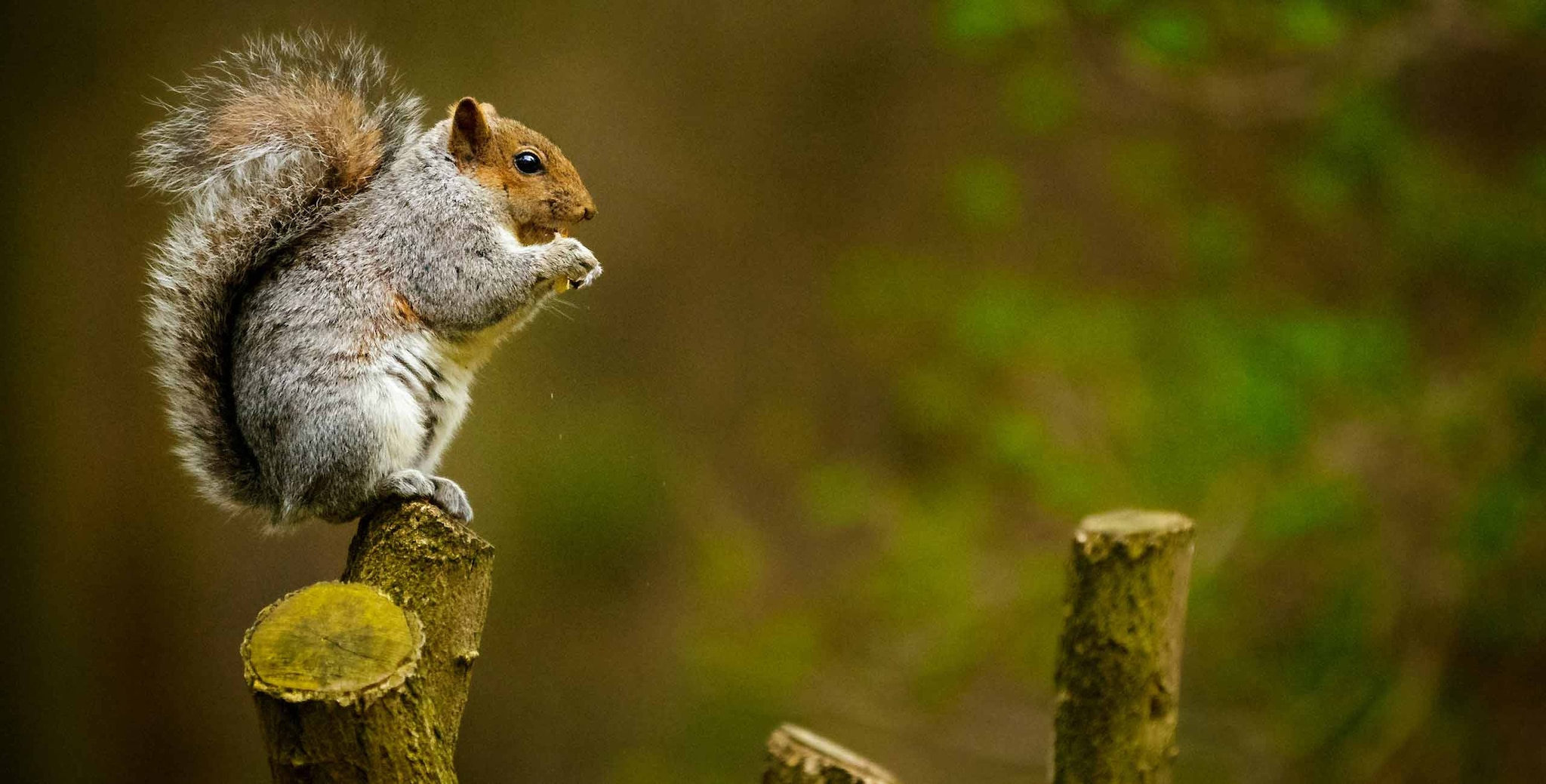
Capable of complex problem-solving, bright-eyed and bushy-tailed squirrels are resourceful creatures with a high degree of tenacity.
There are 272 species of squirrels that fall into three broad categories – flying squirrels, ground squirrels and tree squirrels.7 In spite of their name, flying squirrels aren’t capable of flight – but they can glide. This gliding is achieved using a thin, furry cape-like membrane, called the patagium, which stretches from the wrist to the ankle.8 It helps propel the flying squirrel from tree to tree. Flying squirrels live in wooded areas; they’re commonly found in coniferous and deciduous forests.9 These squirrels are nocturnal, so they aren’t easily spotted during the day, making them somewhat elusive.10
Ground squirrels live in underground burrows and hibernate through harsh winters.11 However, some, such as the California ground squirrel, can be active throughout the year. These squirrels tend to live in colonies – in groups between two and 20 animals.12
A ground squirrel has quite a bit of digging power – their burrows can measure 5 to 30 feet long and are usually 2.5 to 4 feet below the surface.13 Here, the squirrels store food, hibernate and rear their young. However, this burrowing can cause serious issues for homeowners. Their digging can cause damage to landscaping, fencing and buildings. As a result, they’re considered pests in many urban areas. Furthermore, squirrels have been known to cause major power outages and can pose a greater threat to the power grid than cyberattacks.14
Tree squirrels are called seed predators, because they eat seeds even before they have a chance to germinate.15 However, they do make amends, because they’re also considered seed dispersers.16 These squirrels find elaborate hiding places for their nuts, many of which they never dig up and some of which end up germinating.17
The best-known tree squirrel species are the eastern grey, native to North America, and the red squirrel, which is native to England, but which can also be found across Europe and northern Asia.18
On average, squirrels can eat up to 450g of food per week.19 Grey squirrels consume between 40g and 80g of food per day, roughly 10% of their body weight. Red squirrels, being smaller in size, will eat about half that amount.20
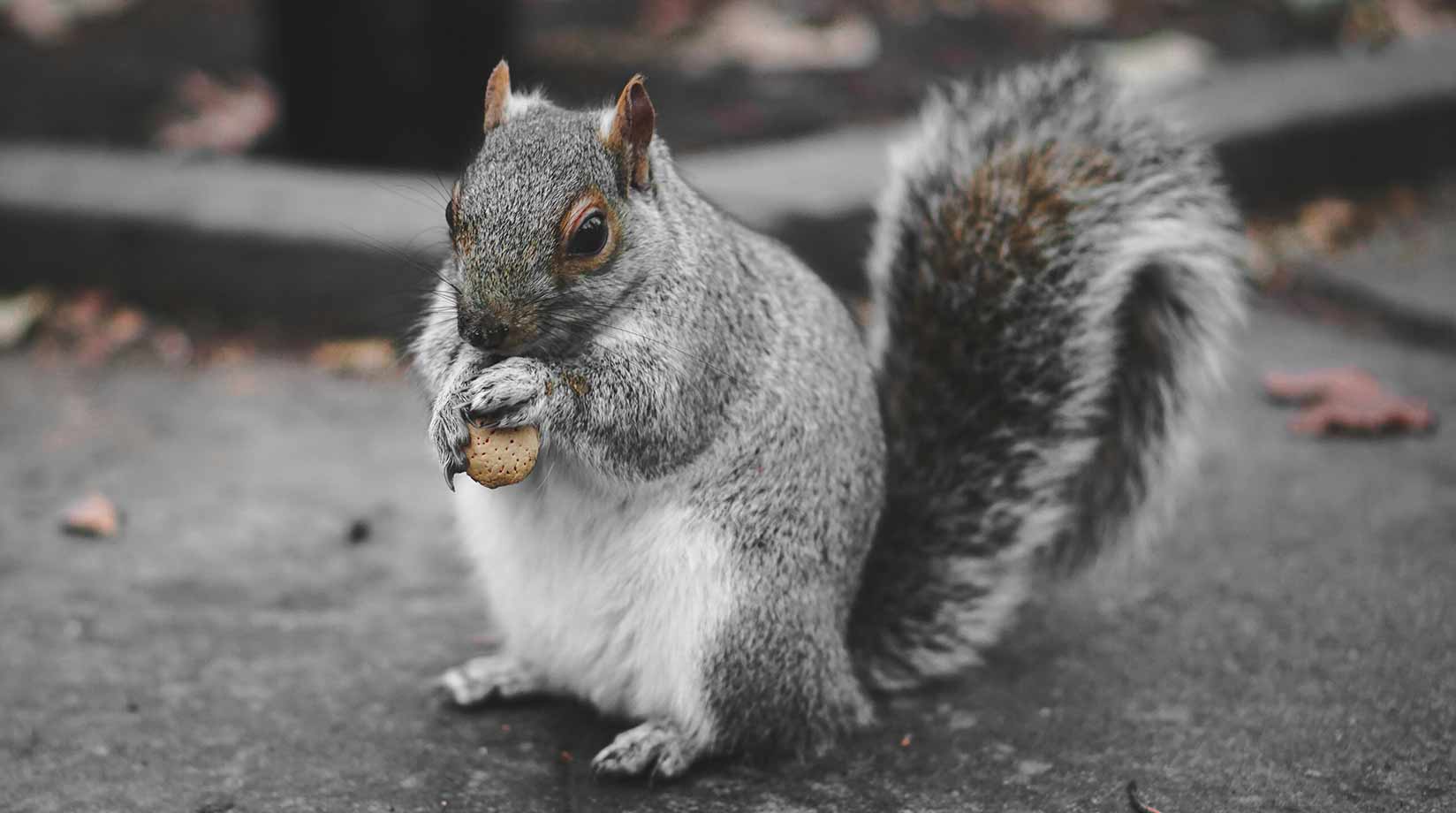
Squirrels have seasonal fluctuations in body weight and during the autumn months, the amount of food they consume increases. Some can increase their body weight by up to 50%.21 This is seen as a precautionary measure. They store fat and bulk up to prepare for the bitter winter months when food may not be so readily available.
Squirrels must eat constantly for another reason as well – their front teeth keep growing throughout their lives, and the act of gnawing keeps this in check. If it weren’t for the constant chewing, a squirrel’s front teeth would quickly grow too big. Overgrown teeth can cause severe pain and distress, since it can put pressure on the gums – causing a condition called malocclusion – when the incisors don’t align. It can even be fatal.22
Yes, squirrels do compete with each other for food and often in quite inventive ways. For instance, eastern grey squirrels devise strategic plans to prevent robbery – from their own kind as well as from other squirrel species. Instead of burying nuts, a squirrel who knows it is being watched will hold the nut in its teeth while going through the elaborate deception of digging a hole. Then, it strategically covers up the hole that it digs, without burying its nut, leaving a trail of empty cache sites behind. This is called "deceptive caching" and it’s an integral part of a squirrel’s feeding strategy.23 Researchers have observed that this activity was aimed at fooling other squirrels, but the nature of that deception can differ. For instance, some squirrels did bury nuts when they were being watched, only to dig them up later and bury them elsewhere. This concealment takes considerable time and energy on the part of the squirrel – but it appears to be an effective strategy to prevent theft. Researchers are unsure whether this behaviour is learned or instinctive.
We do know that one species of squirrel may have an advantage over another while foraging for food, and this edge can end up affecting an entire population. A study published in February 2024 in the Journal of Medical Microbiology noted that ever since the eastern grey squirrel was introduced into the UK from North America in 1876, the red squirrel population in the UK has declined.24 As well as impacting the food resources available, eastern greys also carried a virus that was fatal to the red squirrels. Red squirrels fell sick, grew weaker and could not compete for the same food resources, leading to a steep decline in their numbers.25
Squirrels compete with each other for food often in quite inventive ways.
No, not all squirrels hibernate.
Tree squirrels, encompassing both red and grey squirrel populations, do not hibernate and tend to stay awake all winter long. Instead of hibernating, they use several strategies to help them survive the bitter cold. They build snug nests to conserve their energy.26 They prepare in advance by fattening up during the autumn months, increasing their body weight by as much as 50%. They can rely on these stored reserves of body fat when finding food becomes too difficult.27 They’re also very organised. In addition to caching an extensive reserve of nuts and pinecones in preparation for the cold winter months, red squirrels in Alaska have been known to collect and store wild mushrooms as well.28
Ground squirrels, such as the Mohave (Xerospermophilus mohavensis) found in the deserts of California, hibernate during the dry season from August to February.29
Arctic ground squirrels, on the other hand, do hibernate for the winter; they drastically lower their body temperatures and can remain dormant for up to 8 months.30 Researchers at the University of Alaska Fairbanks are studying these hibernation techniques to explore their potential benefits for humans, including whether they could help heal injuries or protect our brain health as we age.31
Since squirrels are ideal prey for owls and other animals, running is a vital self-defence mechanism.
Tree squirrels in particular are known for their swiftness and agility. Grey squirrels can run at speeds up to 32km/h.32 In comparison, red squirrels run at a speed of 23km/h.33
Grey squirrels are faster than reds, and more agile on the ground. Red squirrels, however, have sharp claws, very long toes and flexible muscles in their hind legs, giving them the power to climb trees quickly and nimbly and to grasp branches.34 This makes them better climbers than runners.
While flying squirrels can run, they’re quite clumsy on the ground. Their agility kicks into gear only when they glide. Typically, they can glide at 150 feet without touching the ground, and in some cases have been known to glide at a height of 500 feet. Their average gliding speed is 48-56km/h.35
Like the greys, ground squirrels are capable runners too, especially white-tailed antelope squirrels. Researchers have recorded their diverse styles of running under lab conditions.36
Yes, squirrels can be territorial creatures. Many will stick to a particular area and rarely venture beyond it. One study showed that both male and female red squirrels were prone to defending their territory – especially when guarding the spruce cones they had cached in the heart of this zone.37
The gender of the squirrel can influence its territorial behaviour. The Kluane Red Squirrel Project revealed that mother squirrels were constantly surveying their range, that they have unique "rattle calls" and that they could recognise the sounds made by their neighbours.38 In the project, if red squirrel mothers sensed that there were many other squirrels in the same territory, they gave birth to young that were slightly bigger, and more likely to survive the competition.39
Born blind, deaf and completely hairless, baby squirrels are entirely dependent on their mother to survive, especially in the first three months of their lives.40 Fortunately, their mothers are good providers. The mother is usually the sole caregiver, feeding her kittens with nutritious milk and lining the nests with soft feathers, moss and leaves to make it warmer for her little ones. It takes three weeks for the kittens to grow hair, which is a major milestone, because it affords them some degree of insulation and protection from the cold.41 A baby squirrel’s muscles grow stronger in its seventh week, and it is typically weaned off its mother’s milk at 10 weeks of age.42 A mother squirrel rarely abandons her babies. A baby squirrel can encounter many predators, including owls, foxes and cats that may destroy nests.43 The Kluane Red Squirrel project found that some squirrel mothers have been known to care for babies other than their own, but only if the abandoned kittens were closely related to her.44 Although baby squirrels are very helpless at birth, they have the best chances of survival while under the care of their mother.
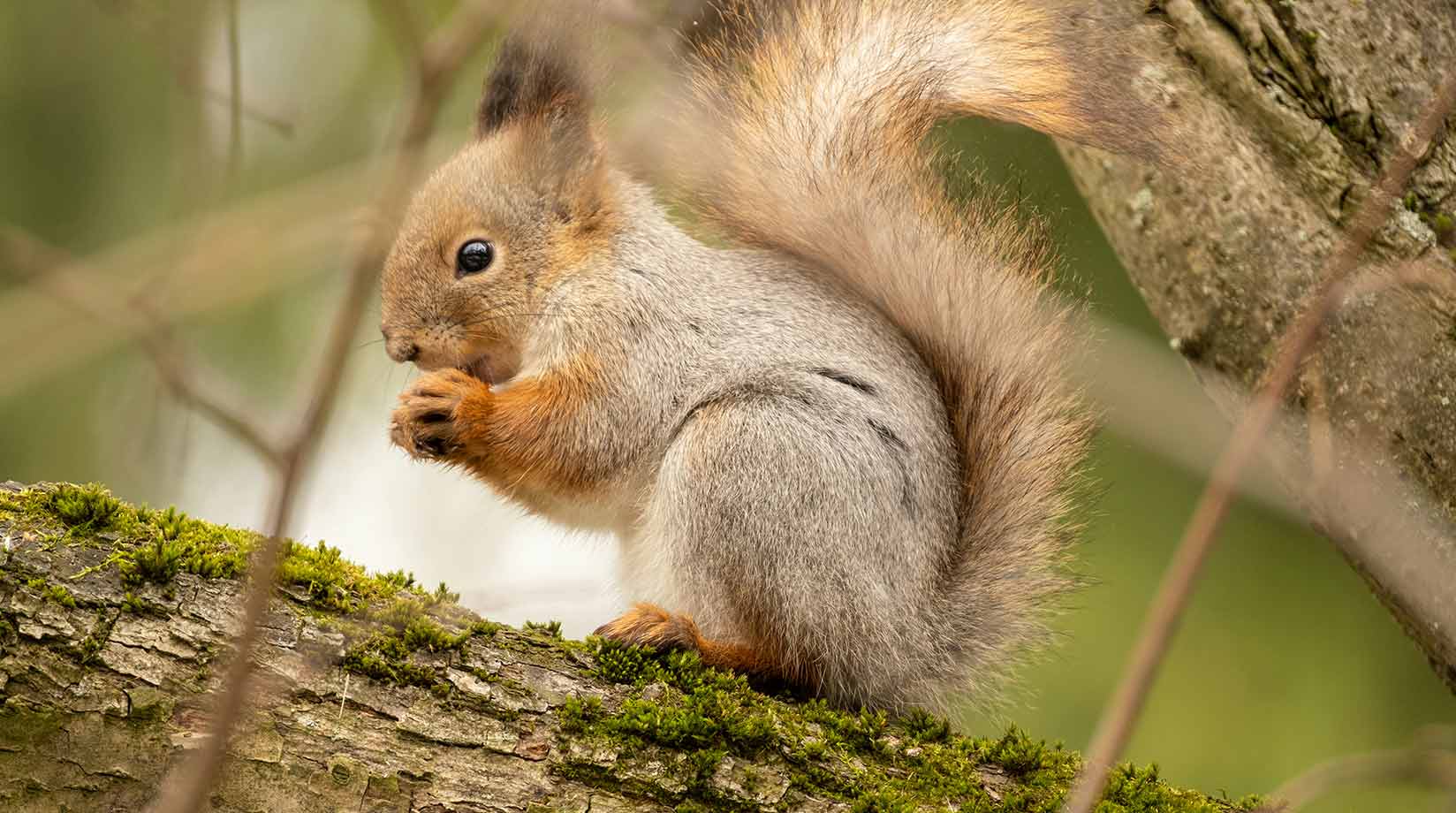
Research has shown that tree squirrels – especially grey squirrels – have had an impact on forest regrowth.45 As they forage for food, they bury their cache of nuts in different hiding places. As a result of burying nuts and seeds, squirrels inadvertently help in their dispersal and that aids the growth of trees.46
Researchers found that grey squirrels tended to be better at seed dispersal than red squirrels.47 There were several reasons why. Grey squirrels were seen to immediately eat the damaged seeds that they had collected, while burying the healthy seeds that had more potential for growth. They’re referred to as “scatter-hoarders”.48 Additionally, they ate the larvae of insects that destroyed the seeds.49
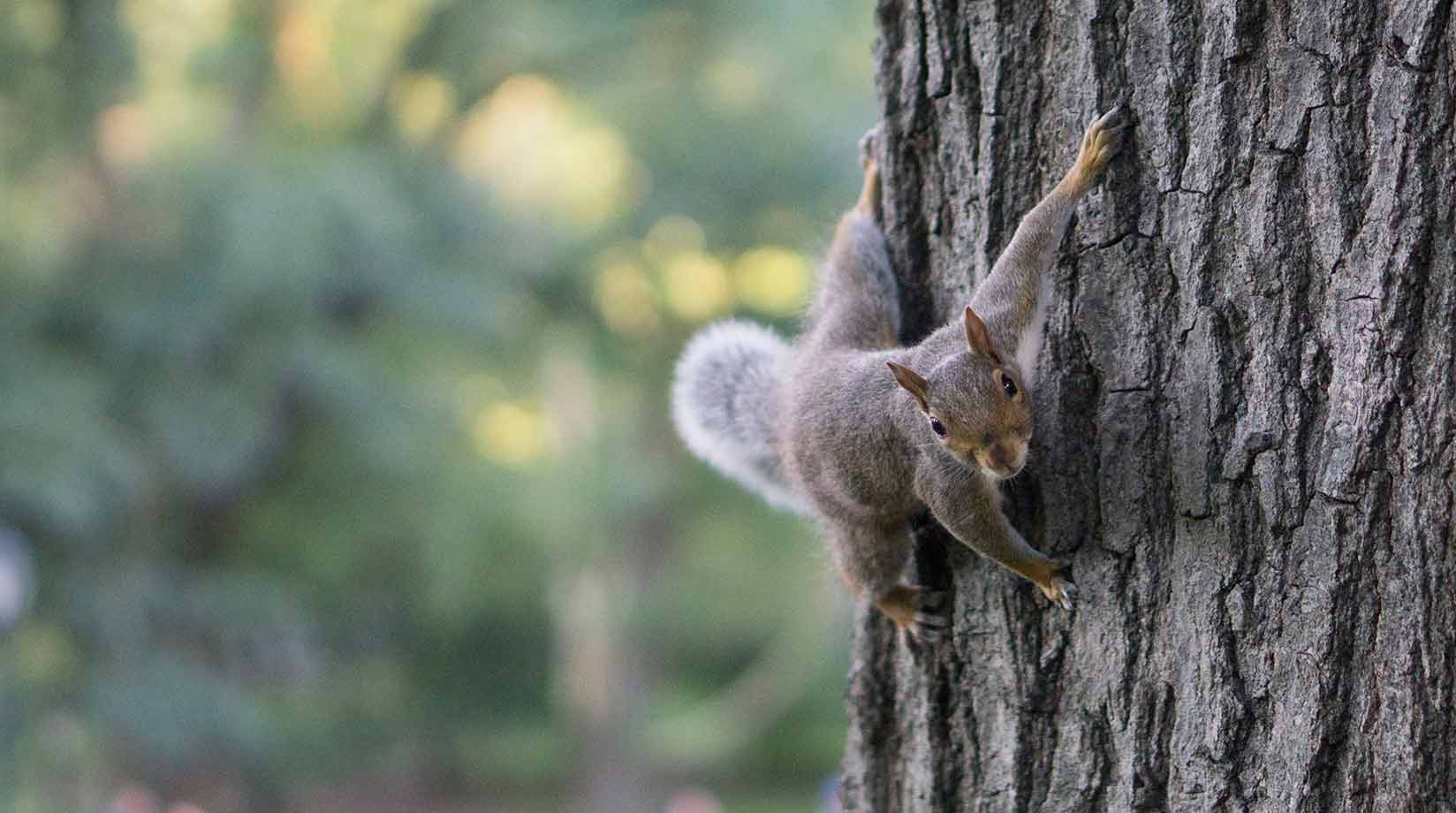
Red squirrels didn’t hoard seeds as much as the greys. They only stashed away a small amount of the seeds they collected and many of these were placed in hollows of trees rather than in the ground.50 They would look for hiding places in the ground only after they had exhausted the space in their tree "larders". This made them less effective at seed dispersal when compared to greys.
Squirrels produce high-pitched squeaking noises that sound like a rapid series of notes, similar to the chirping of a bird. One of their most important vocalisations is the alarm call, which has been observed in all three main squirrel groups: flying squirrels, tree squirrels and ground squirrels.51
The alarm call is a long, repetitive cry used to warn their young of imminent threats or when they sense a predator is nearby. According to mammologist Bryan Hardings, squirrels make aggressive sounds to defend their territory and ward off approaching predators.52 The alarm call culminates in a loud screech – a final attempt to chase intruders away.
Squirrels can also bark when they feel threatened and may make a whistling sound when content.53
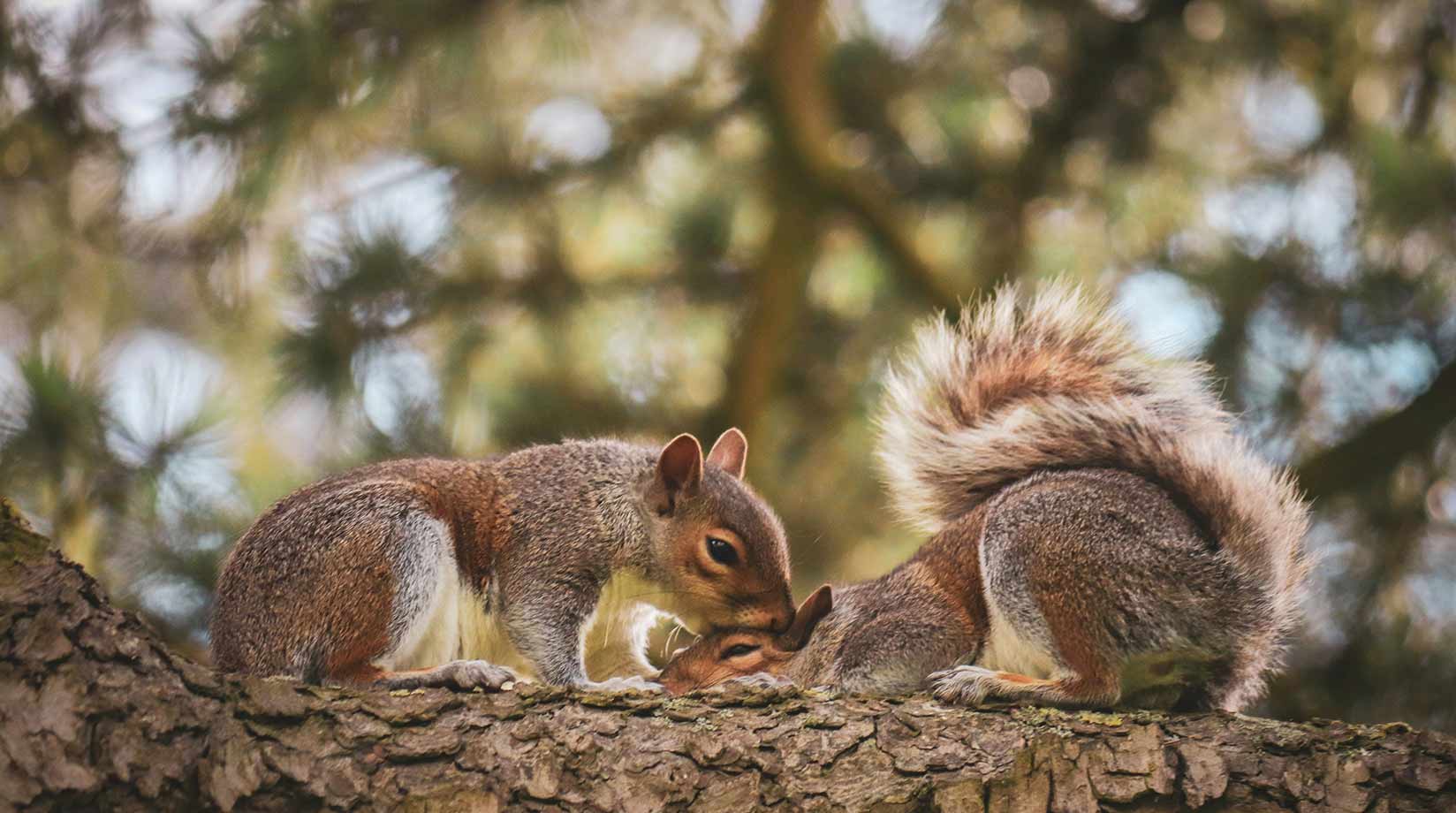
Like many mammals, squirrels can swim. While they aren’t natural swimmers, many squirrel species – including red, grey and fox squirrels – use their tails as rudders, allowing them to steer in the water.54 However, they are not strong swimmers and are incapable of covering long distances – they tire easily and therefore risk drowning if they try to bite off more than they can chew.
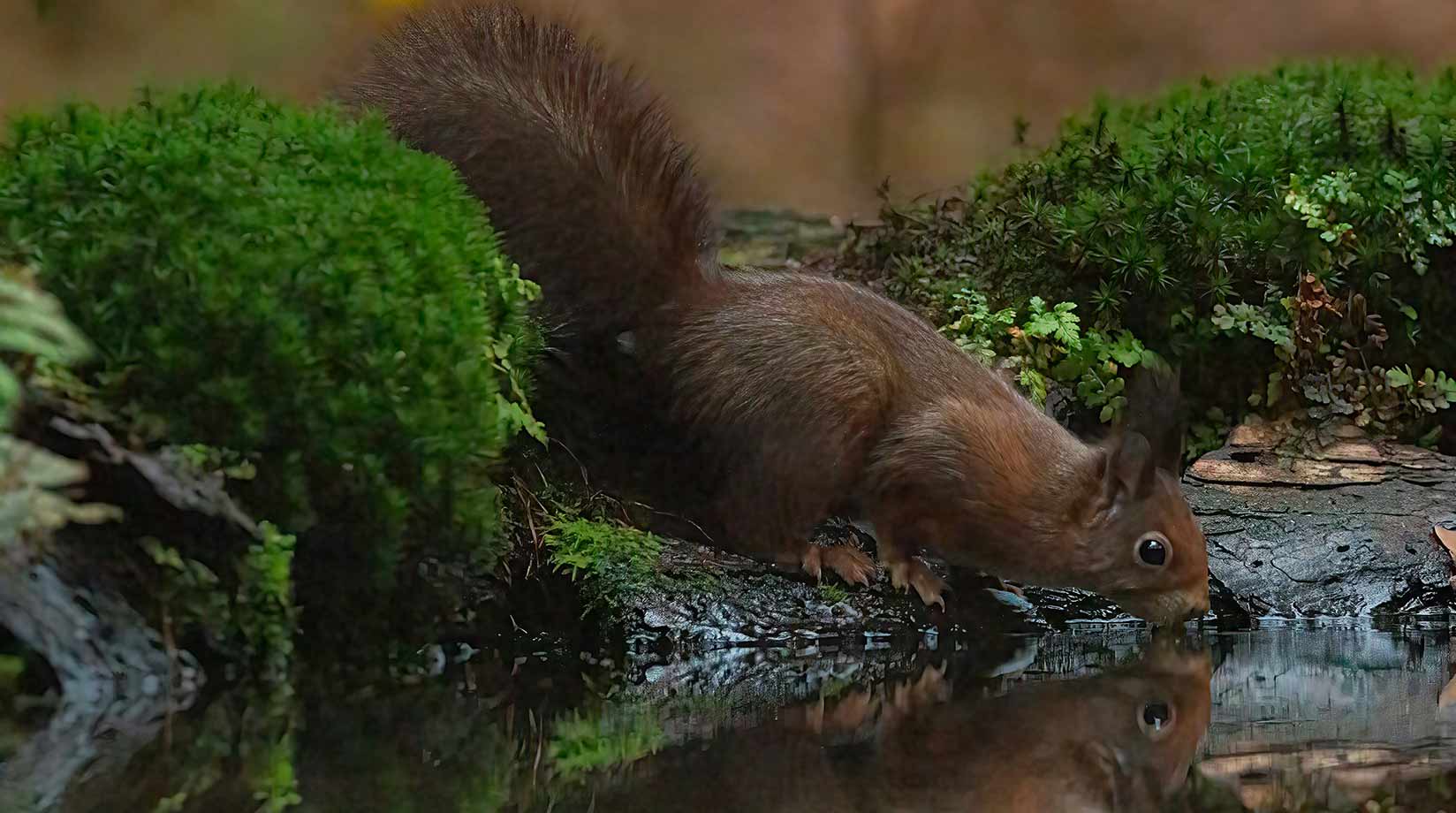
While flying squirrels can swim, it’s not an activity they do often. The webbing on their legs that enables them to glide through the air does not work in the water and so they struggle. Typically, even if they can manage to swim, a squirrel tends to avoid water. They find navigating dry land far easier and swifter.55
This varies, depending on species.
Both red and grey squirrels are diurnal.56 Like humans, they expend most of their energy during the day. They must rest and replenish their energy reserves during nighttime. And they’re early risers. Red squirrels emerge 30 minutes after sunrise, while grey squirrels are active even prior to dawn.57
Ground squirrels are diurnal as well, though they’re more active when the heat isn’t too intense during the day – usually mornings and late afternoons.58
Squirrels live in diverse habitats, including forests, under the ground and in urban spaces – in parks, gardens and cities.
Tree squirrels are highly adaptable, thriving in mature forests and urban environments. Red squirrels, eastern grey squirrels and their close relatives, the fox squirrels, are typically found in hardwood, coniferous forests and mixed forests.60 Fox squirrels prefer open, savannah-like habitats, where the trees are widely spaced.61
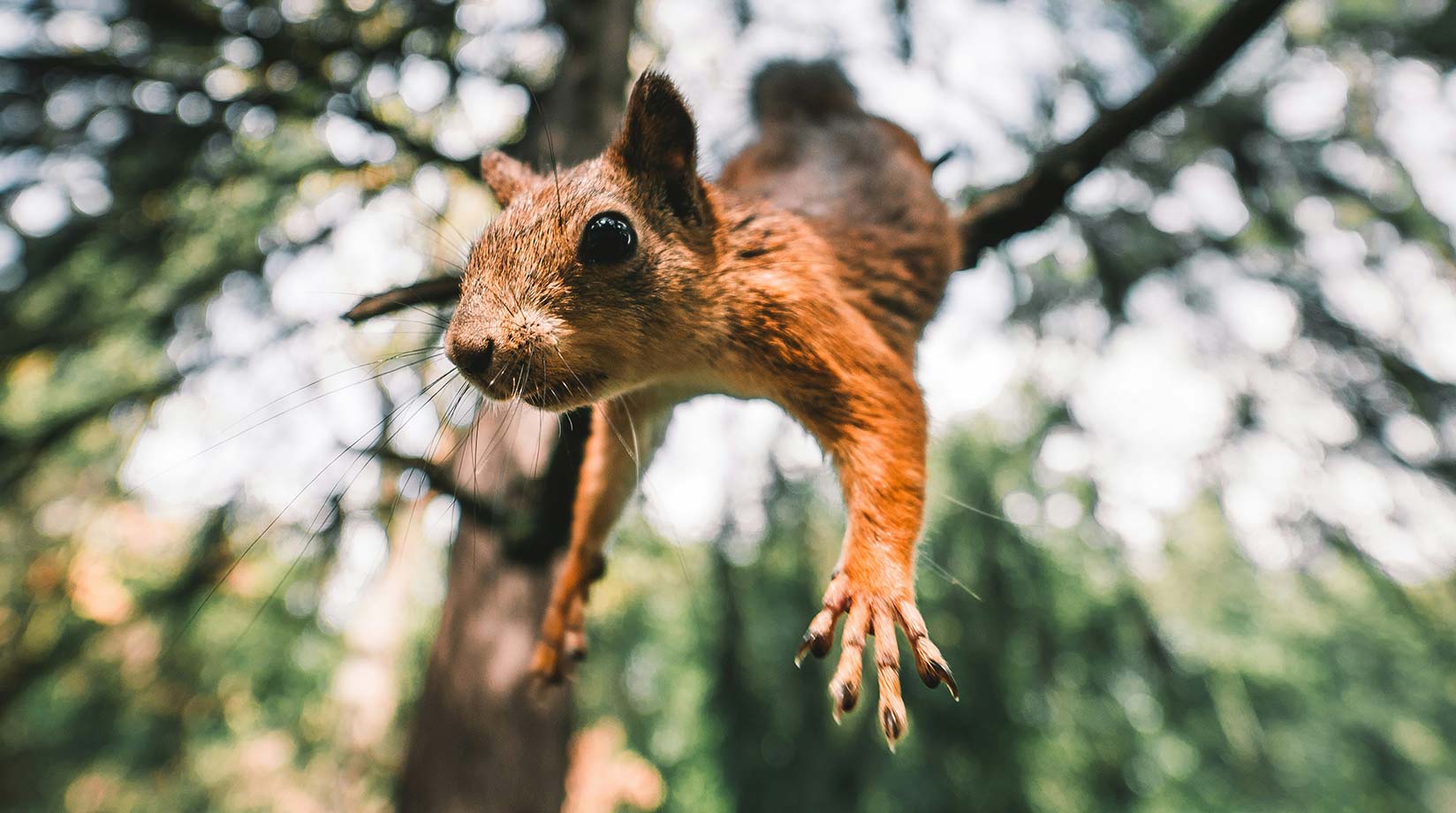
Trees are vital habitats for a tree squirrel. They build their nests in branches, using any material they can find, usually scraggly twigs, leaves and grass. These structures are called dreys.62
Ground squirrels prefer grassland habitats and can adapt to open fields and pastures. They typically burrow into the ground and construct their dens. And since they live in colonies, ground squirrels' dens are interconnected with underground tunnels and chambers.63
Flying squirrels prefer to make their homes in deciduous and mixed forests.64 Like the tree squirrels, they live in nests and in the hollows of trees. However, they don’t always build these nests themselves and can live in nests abandoned by woodpeckers and other birds.65
Yes, they do. Squirrels have higher cognitive abilities than many other mammals and are capable of complex thinking.
A study, published in Proceedings of the Royal Society B journal, led by Itsuro Koizumi of Hokkaido University, Japan, put squirrels' intelligence to the test. 66 Researchers took wild Eurasian squirrels from 11 urban areas across Japan and devised a problem for them to solve.
Nuts were placed on out-of-reach levers. To get the nut, the squirrel had to push a lever if it was close and pull it if it was father away. The researchers made a note of the environmental conditions in the area, such as human interference, the presence of trees as well as the population size of other squirrels.
Out of the 71 squirrels that attempted to solve the food-extraction problem, slightly more than half (53.5%) were successful. However, that success decreased in more built-up areas and where there was more human interference. Interestingly, the squirrels that were able to solve the task repeatedly got better at it over time. When they kept repeating the experiment, the squirrels solved the problem in less time, irrespective of any human disturbance.
The experiment proved that squirrels were able to use logic and problem-solve, and these skills improved the more they completed the task.
No, squirrels are not suited to life as pets. As wild animals, they have complex needs that are best met in their natural habitat. Attempting to domesticate them disrupts their instincts, often leads to serious welfare issues, and is illegal in many places. Additionally, wild animals, including squirrels, can carry diseases like rabies that pose risks to humans.67 However, this is very rare.
In October 2024, in New York city, authorities swooped down on the most famous grey squirrel on the Internet – Peanut – fearing a rabies risk.
Peanut had over 600,000 followers from around the world following his Instagram handle @peanut_the_squirrel12. His caretaker, Mark Longo, shared his many antics in daily video reels. Longo had saved Peanut after an accident and the two grew close. Longo’s posts showed footage of Peanut freely meandering around his house, being dressed up in various outfits and playing out skits with him.
As Peanut's fame grew, sadly his days were numbered. Following complaints about welfare, officials from the state of New York’s Department of Environmental Conservation arrived at Mark Longo’s home to seize Peanut on 30 October 2024. The authorities euthanised the squirrel in order to test for rabies. The test, they said, was mandatory, because the animal had been sharing a home with humans.68
Peanut’s euthanasia sparked outrage online as many had petitioned for his safe return. Longo had been in the process of getting legal clearance to keep a domesticated wild animal at home. He argued that Peanut wouldn’t be able to survive in the wild.
Peanut was a rescue, and a special case – but squirrels are not domestic animals and deserve to live out their lives in the wild.
Featured image © Shane Young | Unsplash
Fun fact image © Andrey Svistunov | Unsplash
Quick facts
Fact file
Capable of complex problem-solving, bright-eyed and bushy-tailed squirrels are resourceful creatures with a high degree of tenacity.
Kits, kittens5
Dray, scurry, squad, colony6
Bird eggs, insects, smaller mammals, smaller reptiles, especially when nuts, seeds and roots are unavailable7
Predatory birds such as hawks, foxes, weasels, coyotes, bobcats, mountain lions, racoons, snakes, domestic dogs, cats, badgers, weasels, pine martens and stoats8
This varies, depending on the species. The eastern grey squirrel has a life span of 2-12 years in the wild; up to 20 years in captivity9
13cm-1m, dependent on species10
10g-1.8kg, dependent on species11
They are found in 53 countries across the world with sizeable numbers in the USA, Russia, Canada, UK, China and India12
An estimated count of 2 billion13
This depends on species and location. Globally, the eastern grey squirrels is viewed as Least Concern.14 The Sri Lankan giant squirrel is Threatened.15 And though the red squirrel is listed as Threatened in the UK, it is of Least Concern globally
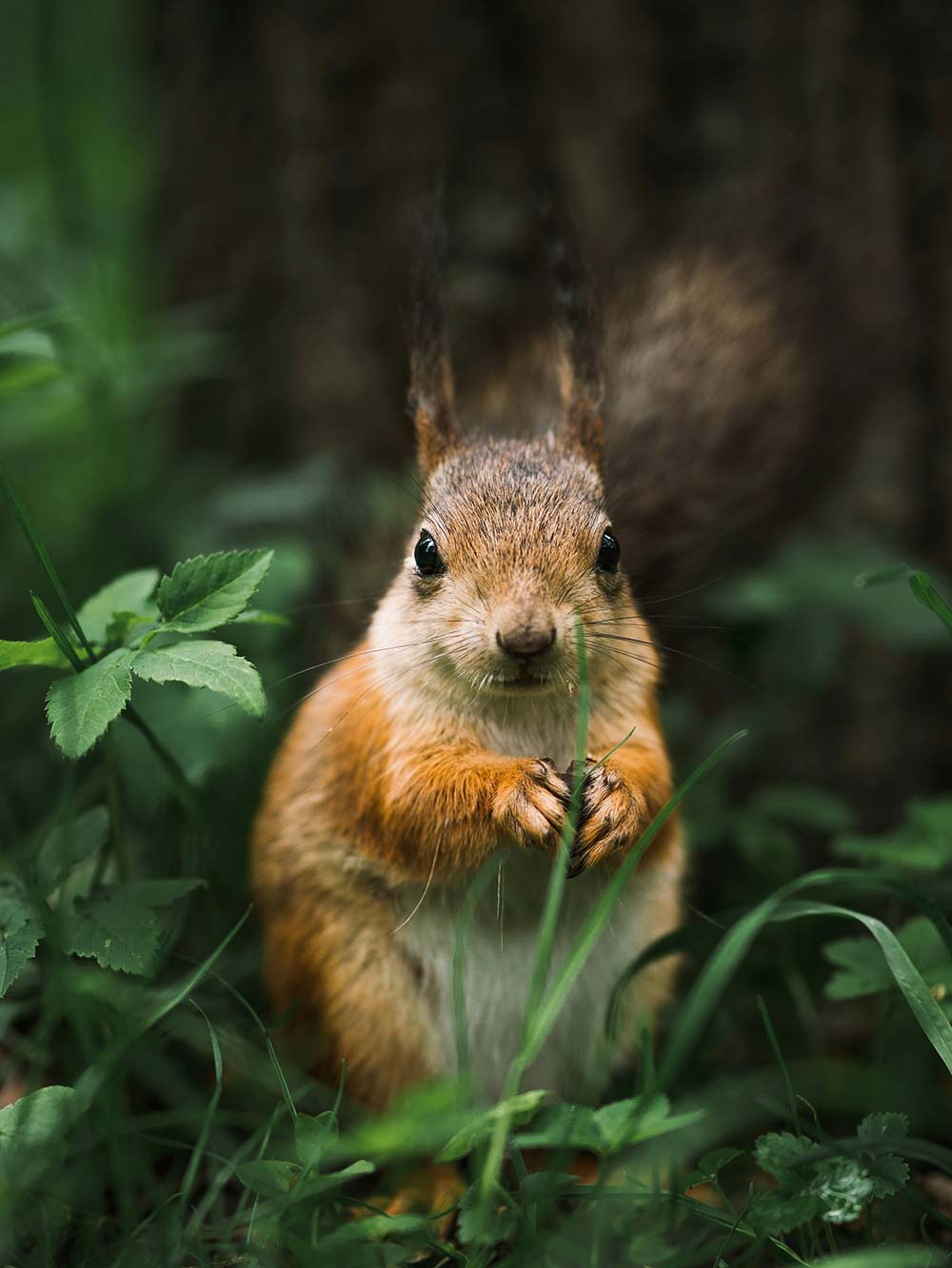
A single squirrel can stash 10,000 nuts a year, over a range of seven hectares!
There are 272 species of squirrels that fall into three broad categories – flying squirrels, ground squirrels and tree squirrels.7 In spite of their name, flying squirrels aren’t capable of flight – but they can glide. This gliding is achieved using a thin, furry cape-like membrane, called the patagium, which stretches from the wrist to the ankle.8 It helps propel the flying squirrel from tree to tree. Flying squirrels live in wooded areas; they’re commonly found in coniferous and deciduous forests.9 These squirrels are nocturnal, so they aren’t easily spotted during the day, making them somewhat elusive.10
Ground squirrels live in underground burrows and hibernate through harsh winters.11 However, some, such as the California ground squirrel, can be active throughout the year. These squirrels tend to live in colonies – in groups between two and 20 animals.12
A ground squirrel has quite a bit of digging power – their burrows can measure 5 to 30 feet long and are usually 2.5 to 4 feet below the surface.13 Here, the squirrels store food, hibernate and rear their young. However, this burrowing can cause serious issues for homeowners. Their digging can cause damage to landscaping, fencing and buildings. As a result, they’re considered pests in many urban areas. Furthermore, squirrels have been known to cause major power outages and can pose a greater threat to the power grid than cyberattacks.14
Tree squirrels are called seed predators, because they eat seeds even before they have a chance to germinate.15 However, they do make amends, because they’re also considered seed dispersers.16 These squirrels find elaborate hiding places for their nuts, many of which they never dig up and some of which end up germinating.17
The best-known tree squirrel species are the eastern grey, native to North America, and the red squirrel, which is native to England, but which can also be found across Europe and northern Asia.18
On average, squirrels can eat up to 450g of food per week.19 Grey squirrels consume between 40g and 80g of food per day, roughly 10% of their body weight. Red squirrels, being smaller in size, will eat about half that amount.20

Squirrels have seasonal fluctuations in body weight and during the autumn months, the amount of food they consume increases. Some can increase their body weight by up to 50%.21 This is seen as a precautionary measure. They store fat and bulk up to prepare for the bitter winter months when food may not be so readily available.
Squirrels must eat constantly for another reason as well – their front teeth keep growing throughout their lives, and the act of gnawing keeps this in check. If it weren’t for the constant chewing, a squirrel’s front teeth would quickly grow too big. Overgrown teeth can cause severe pain and distress, since it can put pressure on the gums – causing a condition called malocclusion – when the incisors don’t align. It can even be fatal.22
Yes, squirrels do compete with each other for food and often in quite inventive ways. For instance, eastern grey squirrels devise strategic plans to prevent robbery – from their own kind as well as from other squirrel species. Instead of burying nuts, a squirrel who knows it is being watched will hold the nut in its teeth while going through the elaborate deception of digging a hole. Then, it strategically covers up the hole that it digs, without burying its nut, leaving a trail of empty cache sites behind. This is called "deceptive caching" and it’s an integral part of a squirrel’s feeding strategy.23 Researchers have observed that this activity was aimed at fooling other squirrels, but the nature of that deception can differ. For instance, some squirrels did bury nuts when they were being watched, only to dig them up later and bury them elsewhere. This concealment takes considerable time and energy on the part of the squirrel – but it appears to be an effective strategy to prevent theft. Researchers are unsure whether this behaviour is learned or instinctive.
We do know that one species of squirrel may have an advantage over another while foraging for food, and this edge can end up affecting an entire population. A study published in February 2024 in the Journal of Medical Microbiology noted that ever since the eastern grey squirrel was introduced into the UK from North America in 1876, the red squirrel population in the UK has declined.24 As well as impacting the food resources available, eastern greys also carried a virus that was fatal to the red squirrels. Red squirrels fell sick, grew weaker and could not compete for the same food resources, leading to a steep decline in their numbers.25
Squirrels compete with each other for food often in quite inventive ways.
No, not all squirrels hibernate.
Tree squirrels, encompassing both red and grey squirrel populations, do not hibernate and tend to stay awake all winter long. Instead of hibernating, they use several strategies to help them survive the bitter cold. They build snug nests to conserve their energy.26 They prepare in advance by fattening up during the autumn months, increasing their body weight by as much as 50%. They can rely on these stored reserves of body fat when finding food becomes too difficult.27 They’re also very organised. In addition to caching an extensive reserve of nuts and pinecones in preparation for the cold winter months, red squirrels in Alaska have been known to collect and store wild mushrooms as well.28
Ground squirrels, such as the Mohave (Xerospermophilus mohavensis) found in the deserts of California, hibernate during the dry season from August to February.29
Arctic ground squirrels, on the other hand, do hibernate for the winter; they drastically lower their body temperatures and can remain dormant for up to 8 months.30 Researchers at the University of Alaska Fairbanks are studying these hibernation techniques to explore their potential benefits for humans, including whether they could help heal injuries or protect our brain health as we age.31
Since squirrels are ideal prey for owls and other animals, running is a vital self-defence mechanism.
Tree squirrels in particular are known for their swiftness and agility. Grey squirrels can run at speeds up to 32km/h.32 In comparison, red squirrels run at a speed of 23km/h.33
Grey squirrels are faster than reds, and more agile on the ground. Red squirrels, however, have sharp claws, very long toes and flexible muscles in their hind legs, giving them the power to climb trees quickly and nimbly and to grasp branches.34 This makes them better climbers than runners.
While flying squirrels can run, they’re quite clumsy on the ground. Their agility kicks into gear only when they glide. Typically, they can glide at 150 feet without touching the ground, and in some cases have been known to glide at a height of 500 feet. Their average gliding speed is 48-56km/h.35
Like the greys, ground squirrels are capable runners too, especially white-tailed antelope squirrels. Researchers have recorded their diverse styles of running under lab conditions.36
Yes, squirrels can be territorial creatures. Many will stick to a particular area and rarely venture beyond it. One study showed that both male and female red squirrels were prone to defending their territory – especially when guarding the spruce cones they had cached in the heart of this zone.37
The gender of the squirrel can influence its territorial behaviour. The Kluane Red Squirrel Project revealed that mother squirrels were constantly surveying their range, that they have unique "rattle calls" and that they could recognise the sounds made by their neighbours.38 In the project, if red squirrel mothers sensed that there were many other squirrels in the same territory, they gave birth to young that were slightly bigger, and more likely to survive the competition.39
Born blind, deaf and completely hairless, baby squirrels are entirely dependent on their mother to survive, especially in the first three months of their lives.40 Fortunately, their mothers are good providers. The mother is usually the sole caregiver, feeding her kittens with nutritious milk and lining the nests with soft feathers, moss and leaves to make it warmer for her little ones. It takes three weeks for the kittens to grow hair, which is a major milestone, because it affords them some degree of insulation and protection from the cold.41 A baby squirrel’s muscles grow stronger in its seventh week, and it is typically weaned off its mother’s milk at 10 weeks of age.42 A mother squirrel rarely abandons her babies. A baby squirrel can encounter many predators, including owls, foxes and cats that may destroy nests.43 The Kluane Red Squirrel project found that some squirrel mothers have been known to care for babies other than their own, but only if the abandoned kittens were closely related to her.44 Although baby squirrels are very helpless at birth, they have the best chances of survival while under the care of their mother.

Research has shown that tree squirrels – especially grey squirrels – have had an impact on forest regrowth.45 As they forage for food, they bury their cache of nuts in different hiding places. As a result of burying nuts and seeds, squirrels inadvertently help in their dispersal and that aids the growth of trees.46
Researchers found that grey squirrels tended to be better at seed dispersal than red squirrels.47 There were several reasons why. Grey squirrels were seen to immediately eat the damaged seeds that they had collected, while burying the healthy seeds that had more potential for growth. They’re referred to as “scatter-hoarders”.48 Additionally, they ate the larvae of insects that destroyed the seeds.49

Red squirrels didn’t hoard seeds as much as the greys. They only stashed away a small amount of the seeds they collected and many of these were placed in hollows of trees rather than in the ground.50 They would look for hiding places in the ground only after they had exhausted the space in their tree "larders". This made them less effective at seed dispersal when compared to greys.
Squirrels produce high-pitched squeaking noises that sound like a rapid series of notes, similar to the chirping of a bird. One of their most important vocalisations is the alarm call, which has been observed in all three main squirrel groups: flying squirrels, tree squirrels and ground squirrels.51
The alarm call is a long, repetitive cry used to warn their young of imminent threats or when they sense a predator is nearby. According to mammologist Bryan Hardings, squirrels make aggressive sounds to defend their territory and ward off approaching predators.52 The alarm call culminates in a loud screech – a final attempt to chase intruders away.
Squirrels can also bark when they feel threatened and may make a whistling sound when content.53

Like many mammals, squirrels can swim. While they aren’t natural swimmers, many squirrel species – including red, grey and fox squirrels – use their tails as rudders, allowing them to steer in the water.54 However, they are not strong swimmers and are incapable of covering long distances – they tire easily and therefore risk drowning if they try to bite off more than they can chew.

While flying squirrels can swim, it’s not an activity they do often. The webbing on their legs that enables them to glide through the air does not work in the water and so they struggle. Typically, even if they can manage to swim, a squirrel tends to avoid water. They find navigating dry land far easier and swifter.55
This varies, depending on species.
Both red and grey squirrels are diurnal.56 Like humans, they expend most of their energy during the day. They must rest and replenish their energy reserves during nighttime. And they’re early risers. Red squirrels emerge 30 minutes after sunrise, while grey squirrels are active even prior to dawn.57
Ground squirrels are diurnal as well, though they’re more active when the heat isn’t too intense during the day – usually mornings and late afternoons.58
Squirrels live in diverse habitats, including forests, under the ground and in urban spaces – in parks, gardens and cities.
Tree squirrels are highly adaptable, thriving in mature forests and urban environments. Red squirrels, eastern grey squirrels and their close relatives, the fox squirrels, are typically found in hardwood, coniferous forests and mixed forests.60 Fox squirrels prefer open, savannah-like habitats, where the trees are widely spaced.61

Trees are vital habitats for a tree squirrel. They build their nests in branches, using any material they can find, usually scraggly twigs, leaves and grass. These structures are called dreys.62
Ground squirrels prefer grassland habitats and can adapt to open fields and pastures. They typically burrow into the ground and construct their dens. And since they live in colonies, ground squirrels' dens are interconnected with underground tunnels and chambers.63
Flying squirrels prefer to make their homes in deciduous and mixed forests.64 Like the tree squirrels, they live in nests and in the hollows of trees. However, they don’t always build these nests themselves and can live in nests abandoned by woodpeckers and other birds.65
Yes, they do. Squirrels have higher cognitive abilities than many other mammals and are capable of complex thinking.
A study, published in Proceedings of the Royal Society B journal, led by Itsuro Koizumi of Hokkaido University, Japan, put squirrels' intelligence to the test. 66 Researchers took wild Eurasian squirrels from 11 urban areas across Japan and devised a problem for them to solve.
Nuts were placed on out-of-reach levers. To get the nut, the squirrel had to push a lever if it was close and pull it if it was father away. The researchers made a note of the environmental conditions in the area, such as human interference, the presence of trees as well as the population size of other squirrels.
Out of the 71 squirrels that attempted to solve the food-extraction problem, slightly more than half (53.5%) were successful. However, that success decreased in more built-up areas and where there was more human interference. Interestingly, the squirrels that were able to solve the task repeatedly got better at it over time. When they kept repeating the experiment, the squirrels solved the problem in less time, irrespective of any human disturbance.
The experiment proved that squirrels were able to use logic and problem-solve, and these skills improved the more they completed the task.
No, squirrels are not suited to life as pets. As wild animals, they have complex needs that are best met in their natural habitat. Attempting to domesticate them disrupts their instincts, often leads to serious welfare issues, and is illegal in many places. Additionally, wild animals, including squirrels, can carry diseases like rabies that pose risks to humans.67 However, this is very rare.
In October 2024, in New York city, authorities swooped down on the most famous grey squirrel on the Internet – Peanut – fearing a rabies risk.
Peanut had over 600,000 followers from around the world following his Instagram handle @peanut_the_squirrel12. His caretaker, Mark Longo, shared his many antics in daily video reels. Longo had saved Peanut after an accident and the two grew close. Longo’s posts showed footage of Peanut freely meandering around his house, being dressed up in various outfits and playing out skits with him.
As Peanut's fame grew, sadly his days were numbered. Following complaints about welfare, officials from the state of New York’s Department of Environmental Conservation arrived at Mark Longo’s home to seize Peanut on 30 October 2024. The authorities euthanised the squirrel in order to test for rabies. The test, they said, was mandatory, because the animal had been sharing a home with humans.68
Peanut’s euthanasia sparked outrage online as many had petitioned for his safe return. Longo had been in the process of getting legal clearance to keep a domesticated wild animal at home. He argued that Peanut wouldn’t be able to survive in the wild.
Peanut was a rescue, and a special case – but squirrels are not domestic animals and deserve to live out their lives in the wild.
Featured image © Shane Young | Unsplash
Fun fact image © Andrey Svistunov | Unsplash
Quick facts
Fact file
Kits, kittens5
Dray, scurry, squad, colony6
Bird eggs, insects, smaller mammals, smaller reptiles, especially when nuts, seeds and roots are unavailable7
Predatory birds such as hawks, foxes, weasels, coyotes, bobcats, mountain lions, racoons, snakes, domestic dogs, cats, badgers, weasels, pine martens and stoats8
This varies, depending on the species. The eastern grey squirrel has a life span of 2-12 years in the wild; up to 20 years in captivity9
13cm-1m, dependent on species10
10g-1.8kg, dependent on species11
They are found in 53 countries across the world with sizeable numbers in the USA, Russia, Canada, UK, China and India12
An estimated count of 2 billion13
This depends on species and location. Globally, the eastern grey squirrels is viewed as Least Concern.14 The Sri Lankan giant squirrel is Threatened.15 And though the red squirrel is listed as Threatened in the UK, it is of Least Concern globally

A single squirrel can stash 10,000 nuts a year, over a range of seven hectares!